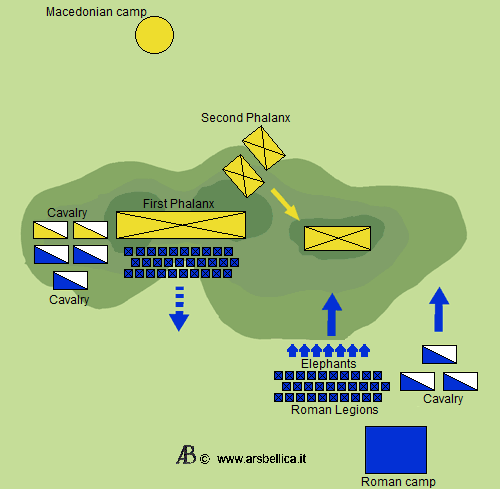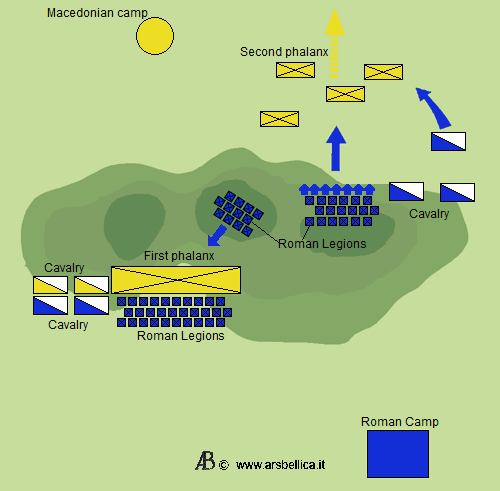

197 BC
At the battle of Cynoscephalae, known, in military terms, as the "encounter battle", the legions of Flamininus attack the phalanx of Philip V, while they are still in the deployment phase, routing them.
CYNOSCEPHALAE

Flaminino, the Roman general, was quaestor in 199 BC and Consul in 198 BC, when he was assigned at the command of a campaign against Philip V of Macedon, who defeated at Cynoscephalae in 197 BC, ending the second Macedonian war and removing then Philip by all his possessions in Greece and Asia minor. In 196 BC, during the Isthmian games held on the isthmus of Corinth, Flaminio proclaimed the independence of Greek city-States previously subject to Macedonia. Afterwards he acted several times in the Greek's politics, to maintain the allegiance to Rome with the fictitious purposes to ensure freedom. In 189 BC he was elected censor in 183 BC and ambassador to King Prusias II of Bithynia, who required the consign of Hannibal, who had taken refuge by the King at Magnesia, after the defeat of Antiochus III the great of Syria, by the Romans.

Philip was King of Macedon from 221 to 179 BC, son of King Demetrius II, ascended the throne on the death of his tutor, Antigonus Doson. Gained fame from a war (220-217 BC) in which, together with the Achaean League, defeated an alliance formed by the Aetolian League, Sparta and Elis; then he allied with Demetrius of Pharos, dangerous Illyrian Prince and, most of all, enemy of Rome. The victories of the Carthaginian General Hannibal in Italy convinced Philip to conclude an alliance with Carthage in 215 BC, hoping, in this way, to secure for himself the Roman possessions in Illyria. The agreement, however, bring on a long conflict with Rome, known as Macedonian war, which eventually imposed Roman rule in Greece. Philip then devoted himself to the reconstruction of his reign reorganizing finances, opening some mines and improving the defenses of Northern frontiers. But the continuous intervention of Rome against Macedonis, following claims of neighbouring States, convinced Philip that the Romans wanted to annex his realm. So in 184-183 BC, and again in 181 BC, he tried, with no success, to extend its dominance in the Balkans.
CYNOSCEPHALAE
At the end of the Punic Wars the political, economical and even cultural scenario of Rome was deeply transformed. The expansionist perspective on political and military plan of the Republic were outputs from the confines of the Italian peninsula to consider the entire Mediterranean basin as an area of interest. In addiction, the refining of diplomatic and military elements, especially the army's renovation, offerd to the Republic the means to act in areas that, until few years before, would not have been possible to consider. The rising, within the Roman society, of a business class, the equites (the Knights), that much weight should have in the incoming events, had joint the economic imperialism of the "nomine novi" with the desire of military supremacy in the most advanced areas of ancient nobilitas. The political and social structure that had created such support is offered to further growth of the Roman power; the Hellenistic kingdoms, Greece in particular, represented the main objectives of such appetites. Rome had already intervened, in 211, supporting a war against Macedon, the hegemonic power in the Hellenic peninsula and an ally of Carthage, conducted by some of the Greek States. However, with the army of Hannibal in the Italian peninsula, Roman commitment was bland and the Macedonian Kingdom had got away with little damages. After the Punic War, the Romans were now ready to fight versus Philip V, King of Macedon, and above all to replace the influence of the latter in the confused political situation in Greece.
CYNOSCEPHALAE
In the western Mediterranean, since the battle of Marathon in 490 BC, the Hoplite phalanx before and then after the introduction of the Macedonian phalanx, was considered as the most powerful military formation and was believed to be invincible. The Phalanx, for three centuries, was the base of Western armies of the era. It's no coincidence that all wars, between the diadochi, between Hellenistic kingdoms and in the Pyrrhic wars, were fought with armies that at the center of their line deployed units of solid pikemen in the phalangitic order. The advent of Rome on the political and military theater of Eastern Mediterranean, decreed a radical change: the flexibility of the Legion to manouver, its adaptability to different soils as to changing, and often unpredictable, tactical situations, proved to be the winning factors.
In front of the lightness of the Legionary deployment, the Phalanx showed all his limitations, which were well hidden in a almost uniformed fighting style, essentially identical within the "Koiné" of Greek language. The need to surround the Phalanx with specialist units, as Peltast, light infantrymen, shooters, to protect the vulnerable flanks of this heavy and deep formations of pikemen in difficult terrains or tactical situations, seemed to be developed intentionally to enhance consistency, maneuverability and adaptability of Legionary formations. The battle of Cynoscephalae, which ended the second Macedonian war starting the Roman hegemony over Greece, was the evident demonstration of this superiority. It is also interesting to note that both, the Phalanx and the Legion were, basically, expression of a way of understanding the war very similar. Indeed, in both cases they were armies formed by citizens who perceived the act of carry weapons as something intimately connected to the exercise of political rights and the sense of belonging to a structured State. Starting from this basis, historians first and foremost American historian Anthony Santosuosso, rightly define the military history of ancient Greece, Hellenistic kingdoms and Republican Rome as the era of citizen-soldier.
CYNOSCEPHALAE
Unlike the Hellenistic phalanx, the Roman legionaries were armed with a heavy javelin, called pilum; a lighter armament and less tied to the formation of the closed Hellenistic Sarissa, long up to six metres. This weapon allowed the legionaries an infinitely greater elasticity tactic on the battlefield and proved to be suitable for the type of warfare conducted by the legions. The pilum (plural pila) equipped the first two ranks of legionary units (manipula) and was a typically Roman design.
Consisted of a long wooden rod, approximately 130 cm, on which was fitted a piece of iron, about 70 cm, ending with a double harpoon tip. The Legionnaires had two pila, one of which was fitted with a load placed at the top of the metal part.
Just before the impact a real "rain" of pila would dampen the momentum of the opponents.
When a heavy pilum was sticking in a shield made it essentially impossible to use because, due to the shape of its peaks, was difficult to remove. Although not pierced an enemy, thereby depriving its defense, leaving it uncovered to subsequent launches. Once launched the pila, the legionnaire unsheathe the gladio, the short sword of Iberian origin which was equipped, and approached the enemy, upsets by launches, attacking him in a hand-to-hand combat. It was with this tactic that the legions came out victorious in every battle that saw opposing to the Hellenistic phalanx, as at Cynoscephalae.
CYNOSCEPHALAE
In 201 BC, Attalus of Pergamum, at war with the Macedonian King Philip V, appealed to the Roman Senate for a support: this was what Rome waited for, so an irrevocably ultimatum was sent to Philip. According to this ultimatum, the Macedonian King was supposed to compensate Attalids, would have to commit to not move war against Egypt and to not intervene in the policy of the Greek States; in practice, Macedonia would have to cancel its foreign policy. Obviously Philip refused, giving the Senate a pretext to land an army on the coast of Epirus.
In 199, a Roman army led by Consul Sulpicius Galba, came into Macedonia and, before the winter, legionaries had a small clash against Philip's forces at Ottobolos, which resulted in a substantial stalemate. It was not a great campaign, but had demonstrated to the Greeks that Rome was able to maintain an army in Macedonia and, during the winter, the Aetolian League, the strongest grouping of Greek States, made Alliance with Rome. Strengthened by the Greek allies, the new Roman Commander in Macedonia, Titus Quinctius Flamininus, in 197 faced the Macedonian army at Cynoscephalae, "hills dog's head", in Thessaly.
CYNOSCEPHALAE
Flamininus, at Cynoscephalae deployed had four legions, two Roman and two allied, up to a total of 22,000 men, in addition to 4,000 infantrymen and 2,000 heavy Peltast of the Aetolian League. The light infantry had 1,200 men plus 800 mercenaries from Crete. The cavalry was composed of 2,400 men toghether with 20 war elephants.
On the opposite side of the battlefield, Philip deployed an army of 25,500 men; composed of a 16,000 heavy phalangitic infantry, 1,500 mercenaries and 4,000 Peltast; the light infantry had about 2,000 soldiers. The Knights were only 2,000 between Macedonians and Thessalians.
CYNOSCEPHALAE
The battle of Cynoscephalae perfectly represent what in military terms is called "encounter battle". On the ridge of Cynoscephalae hills met for first light infantry units of the two armies, while the bulk of the troops was still in march and was converging towards the battlefield.

The arrival of Roman reinforcements at Cynoscephalae, drove back the light Macedonians infantrymen. Thereupon, Philip, who had split into two separate units his Phalanx, was deployed the first heavy infantry unit on its right, so to leave the space at left for the second unit.
While the Macedonian left wasn't yet arrived on the field, Philip attacked with his right side, moving backwards the two legions of Flamininus deployed on that side. But Flamininus, who had already deployed the other two legions and elephants in front of the Macedonian left, attacked the Phalanx that was still struggling for the shift from march formation to the battle one. The Phalanx wasn't able to resist at the roman impact and routed.

Thereupon, Flamininus was able to help his own left flank where two legions, a Roman and an Italic one, were still under the pressure of the Macedonian phalanx. With a conversion on left, the Romans sent twenty maniples to attack the right side of the phalanx, which, in that particular ponit, was under the dircet command of Philip, and once received the impact of the Legion, the phalanx formation was soon disrupted. Once lost cohesion, the Phalanx was an easy prey for the Roman infantry and the only chance remained for Macedonians was to abandon the field.

In the massacre that followed the end of the battle, the Macedonians, surrounded, lifted the pikes up, as a sign of surrender, but the Romans did not understand the gesture and continued the carnage. At Cynoscephalae Macedonian casualties at the end of the battle counted 8,000 dead and 5,000 prisoners, while the army of Flamininus had lost only 1,000 men.
CYNOSCEPHALAE
With the defeat of Cynoscephalae Philip lost the control on the Greek policy. Rome had proved not only to be able to set up a successful campaign in the heart of the Hellenistic world, but also to be able to insert, as a regulator, in the complex diatribes that shook the Hellenistic world.
Rome also forced Philip to disarm the fleet, providing hostages to the Senate and the payment of a large war indemnity. After the battle of Cynoscephalae, although was formally an ally of Rome, Macedonia become a peripheral state of the Roman Republic.
Twenty-five years later, the Macedonian King Perseus tried to regain the autonomy for his country, starting the third Macedonian war. But once again, as at Cynoscephalae, the Macedonian phalanx was tactically inferior compared to the Roman Legion and, with the defeat of Pydna on 22 June 168 BC, Macedonia lost its independence forever, ending two centuries in which the small country of Northern Greece was at the Centre of the Mediterranean world.